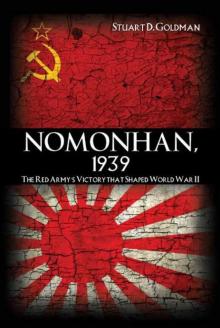Nomonhan, 1939: The Red Army's Victory That Shaped World War II 

Genre: Other9
Published: 2012
View: 2084
Read OnlineRead Nomonhan, 1939: The Red Army's Victory That Shaped World War II Storyline:
This is the story of a little-known Soviet-Japanese conflict that influenced the outbreak and shaped the course of the Second World War. In the summers of 1937, 1938, and 1939, Japan and the Soviet Union fought a series of border conflicts. The first was on the Amur River days before the outbreak of the 2nd Sino-Japanese War. In 1938, division-strength units fought a bloody 2-week battle at Changkufeng near the Korea-Manchuria-Soviet border. The Nomonhan conflict (May-September 1939) on the Manchurian-Mongolian frontier, was a small undeclared war, with over 100,000 troops, 500 tanks and aircraft, and 30,000-50,000 killed and wounded. In the climactic battle, August 20-31, the Japanese were annihilated. This coincided precisely with the conclusion of the German-Soviet Nonaggression Pact (August 23, 1939) – the green light to Hitler's invasion of Poland and the outbreak of WW II one week later. These events are connected. This book relates these developments and weaves them together.From May through July 1939, the conflict was provoked and escalated by the Japanese, whose assaults were repulsed by the Red Army. In August, Stalin unleashed a simultaneous military and diplomatic counter strike. Zhukov, the Soviet commander, launched an offensive that crushed the Japanese. At the same time, Stalin concluded an alliance with Hitler, Japan's nominal ally, leaving Tokyo diplomatically isolated and militarily humiliated.The fact that these events coincided was no “coincidence.” Europe was sliding toward war as Hitler prepared to attack Poland. Stalin sought to avoid a two-front war against Germany and Japan. His ideal outcome would be for the fascist/militarist capitalists (Germany, Italy, and Japan) to fight the bourgeois/democratic capitalists (Britain, France, and perhaps the United States), leaving the Soviet Union on the sidelines while the capitalists exhausted themselves. The Nazi-Soviet Pact pitted Germany against Britain and France and allowed Stalin to deal decisively with an isolated Japan, which he did at Nomonhan.Zhukov won his spurs at Nomonhan and won Stalin’s confidence to entrust him with the high command in 1941, when he halted the Germans at the gates of Moscow with reinforcements from the Soviet Far East. The Far Eastern reserves were deployed westward in the autumn of 1941 when Moscow learned that Japan would not attack the Soviet Far East, because it decided to expand southward to seize the oil-rich Dutch East Indies, which led them to attack Pearl Harbor.The notorious Japanese officer, TSUJI Masanobu, who played a central role at Nomonhan, was an important figure in the decision to attack Pearl Harbor. In 1941, Col. Tsuji was a staff officer at Imperial General HQ. Because of the U.S. oil embargo on Japan, the Imperial Navy wanted to seize the Dutch East Indies. Only the U.S. Pacific Fleet stood in the way. Some army leaders, however, wanted to attack the U.S.S.R., avenging the defeat at Nomonhan while the Red Army was being smashed by the German blitzkreig. Tsuji, an influencial leader, backed the Navy position that led to Pearl Harbor. According to senior Japanese officials, Tsuji was the most influential Army advocate of war with the United States. Tsuji later wrote that his experience of Soviet fire-power at Nomonhan convinced him not to take on the Russians in 1941About the AuthorStuart D. Goldman is a scholar in residence at the National Council for Eurasian and East European Research in Washington, D.C. From 1979 2009, he was the senior specialist in Russian and Eurasian political and military affairs at the Congressional Research Service of the Library of Congress. A resident of Rockville, MD, he holds a PhD from Georgetown University.Pages of Nomonhan, 1939: The Red Army's Victory That Shaped World War II :